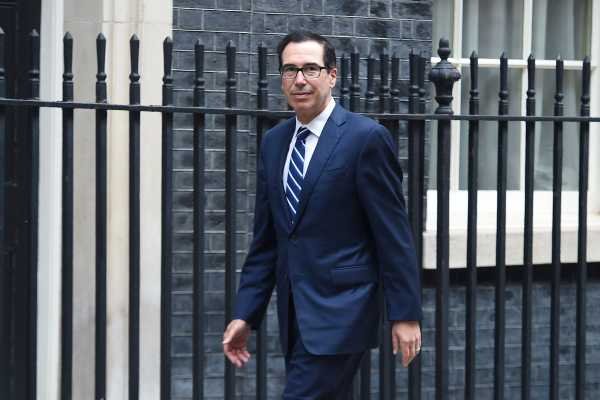
The Trump administration has a new plan to re-privatize the mortgage groups Fannie Mae and Freddie Mac — reversing one of the first actions taken to address the 2008 financial crisis and raising the prospect of a fundamental reworking of the multi-trillion-dollar market in mortgage-backed securities. The plan is on the table in part because the 2008 nationalization was a stopgap measure that few really wanted.
But Fannie Mae and Freddie Mac are still with us in this form 11 years and two presidents later. One reason is conservatives spent the better part of a decade pushing to get the government entirely out of the mortgage business — a step that could have meant huge changes for how American homeownership works, possibly including the death of the traditional 30-year mortgage.
Treasury Secretary Steve Mnuchin’s blueprint would abandon that libertarian dream, seeking instead to take Fannie and Freddie out of public control while minimizing disruption to the mortgage market. That means formally admitting that these companies will be bailed-out again if they get into trouble, with a new regulatory structure designed to prevent those bailouts from being costly to taxpayers.
This raises the big picture question of why bother to go through privatization at all if the goal is mostly to keep things the same. Hanging over that question is the struggle of a handful of hedge fund managers (several of whom are allied to President Donald Trump) to secure a huge payday for themselves. The Treasury blueprint leaves that topic — and several other crucial related ones — hazy, even while including a somewhat detailed wish list of unrelated conservative regulatory reforms.
But conservative die-hards don’t share the main goal of preserving a large government role in the home mortgage business. If Trump wants real action on this front, he’s going to have to embrace bipartisan legislating, and it’s not clear he’s capable of doing that.
This is unfinished business from the George W. Bush administration
To understand what this is about you need to go back in time. Way back, really, to the Great Depression and the New Deal. Back then, President Franklin D. Roosevelt’s administration pushed through a suite of measures designed to get more Americans to build and buy houses. That included the creation of the Federal National Mortgage Association (FNMA, or “Fannie Mae”), which was charged with doing something called “mortgage securitization.”
The aim was simple: to encourage banks to issue more mortgages by minimizing the risks they’d take on. The way this works is that FNMA borrows money and uses it to buy mortgages from banks. These days, it then packages the mortgages and sells them off again as mortgage-backed securities.
This securitization process pools mortgage risk across the entire country. Whereas previously a given bank would be highly exposed to idiosyncratic risks to the housing market of one particular place, FNMA bought mortgages from all over the place and would be in fine shape, absent a housing bust all across the country (which, of course, is what happened under President George W. Bush). The agency was also able to take advantage of the fact that, as a government entity, it could get away with paying a relatively low interest rate on its debt.
Those low rates to an extent were passed on from banks to consumers. So the whole FNMA set-up helps explain why many middle-class Americans have been able to get a large loan to buy a house on the attractive terms typical of the standard 30-year mortgage. Right at the beating heart of American bourgeois capitalism was a huge government agency. An agency that somewhere along the way picked up the cute nickname “Fannie Mae.”
So it went until the Housing and Urban Development Act of 1968. President Lyndon B. Johnson’s administration, which wanted to make the federal debt load look smaller, turned Fannie Mae into a private company. Then in 1970, Congress created a Fannie Mae competitor, the Federal Home Loan Mortgage Corporation (“Freddie Mac”), which did basically the same thing.
Fannie and Freddie were odd ducks. On paper, they were just regular old private companies owned by shareholders and managed for profit. But Fannie’s corporate headquarters was in Washington, DC, and Freddie Mac HQ was across the river in Virginia. And their CEOs tended to be political people (a former Congress member, Walter Mondale’s campaign manager, and Bill Clinton’s budget chief, to name a few of the résumés), not to mention that they have a special government agency to regulate them and certain congressional mandated goals to do things like promote affordable housing.
People called them “government-sponsored enterprises,” and the interest rate that they paid on their debt looked more like the interest rate paid on federal government debt than like normal private sector debt. Financial markets, in short, acted as if Fannie and Freddie were still part of the government and sure to get a bailout in case anything bad happened.
Then toward the end of the Bush administration, something bad happened. The housing market collapsed nationally, and suddenly rather than being protected by diversification, Fannie and Freddie were just holding the bag for a whole nationwide housing bubble.
Lo and behold, a bailout was organized. But not TARP, the main bailout for the banking industry. Several months before that bailout in 2008, Congress passed the Housing and Economic Recovery Act, which authorized the federal government to take Fannie and Freddie into what the law called conservatorship. Under conservatorship, the government gave Fannie and Freddie a bunch of money so that Fannie and Freddie could keep paying their debts and the whole plumbing of the mortgage system could continue working.
While TARP (the Troubled Asset Relief Program) treated bank shareholders’ with kid gloves — essentially asking for repayment of what was given with a small amount of interest — conservatorship was harsh. The private shareholders still in some sense owned their shares, but government regulators made all of the decisions. The companies had in practice been nationalized, but formally speaking the shareholders were still out there. So things started to get weird.
Hedge funds are hoping for a payday
The Bush administration didn’t do anything more with Fannie and Freddie, leaving it up to the next administration. Then when Barack Obama first took office, he had better things to do than to muck around with this issue, and kind of hoped Congress would work something out.
But working something out proved challenging. Ideologues on the right thought that it was time for the government to get out of the mortgage business completely. To them, the lesson of Fannie and Freddie and the crash was that the whole concept of a “government-sponsored entity” was ill-advised, and they wanted to just sunset the companies’ existence.
To people on the left, the idea of simply returning them to their pre-Lyndon B. Johnson status as government agencies was attractive. But politicians in the center wanted to have it both ways — have the government be involved enough in the mortgage market to keep subsidized 30-year mortgages available, but also somehow not have the government providing an open-ended guarantee of a bailout.
Various Congress members worked away at various versions of this idea, but it was slow-going. And in the interim, Fannie and Freddie started to be profitable again. That led the Obama administration to declare in 2012 that all Fannie and Freddie profits would be immediately “swept” into the main Treasury account, leaving only meager cash on the government-sponsored entities’ books. This was supposed to simultaneously make the budget deficit look smaller and increase pressure on Congress to come up with something.
Around this time, some hedge fund managers got an idea they liked better. They bought up tons of basically worthless shares in the companies and began agitating for a solution they called “recap and release.” In other words, they wanted Treasury to stop sweeping up profits, and let the cash stay with Fannie and Freddie. That would allow them to build up a large enough cash buffer to work as viable businesses (they’d be “recapitalized”), at which point the government could simply release them from conservatorship. That would avoid the need for Congress to answer any of the outstanding policy questions — and create a huge financial windfall for the funds who had bought the worthless stock.
The Obama administration fought this idea vociferously, which is one reason John Paulson and Steve Schwarzman — two of the main hedge fund managers behind recap and release — became solid Trump backers. But ideological conservatives didn’t like this idea because the “release” part of recap and release would simply set the country up to do the whole boom-bust-bailout cycle all over again. So the topic continued to linger for years, until the Treasury Department released this week’s report.
Mnuchin wants privatization — plus a government guarantee
The new Treasury plan completely punts on this question of what happens to the existing Fannie and Freddie shareholders.
Instead, it just says they should be privatized through some unspecified mechanism. But rather than going back to the old system of a wink-nudge implicit guarantee, Mnuchin’s plan calls for an explicit government guarantee that will be structured like a kind of insurance policy. Fannie Mae and Freddie Mac will both pay an annual fee to the government, and in exchange their loans will be guaranteed by the federal government. That in turn is supposed to be paired with regulatory efforts to prevent them from abusing their guarantee.
Conceptually, this seems to provide what many politicians imply they want — the affordable 30-year mortgages that only government action can provide, but without the embarrassing socialism of having the federal government at the commanding heights of the housing finance system.
On the other hand, it’s hard to say what advantage exists to this system over having these companies be public entities. Making the putatively “private” system work will depend entirely on the government setting the price of the insurance guarantee correctly and doing a good job of supervising Fannie and Freddie as regulators. They would be completely dependent on the federal government for their business model to be viable. All this plan does is introduce a bunch of questions about how exactly to launch the new system.
The report does have a clearer point in a set of other regulatory ideas aimed at addressing some conservative critiques of the government-sponsored entities. The Treasury plan calls, for example, for affordable housing functions to be mostly carved off from Fannie and Freddie and assigned to the Department of Housing and Urban Development, where they can be squeezed in the normal appropriations process rather than taking advantage of cross-subsidies. The report also suggests that Fannie and Freddie might pull out of multifamily housing entirely, or perhaps refuse to finance loans in jurisdictions that adopt rent control laws.
Another thing that’s unclear from reading the report, however, is how the administration plans to actually proceed from here.
Changing the system requires congressional action
Treasury’s report makes a series of recommendations, noting next to each one which recommendations require congressional action and which can be done administratively. Even on the administrative front, there is some complexity. Different authorities are in the hands of different agencies, and Trump’s appointees may not be entirely like-minded on some of these questions.
That kind of granular breakdown, though in some ways welcome, is in other ways a bit misleading.
The heart of the proposed new system is the government guarantee of Fannie Mae and Freddie Mac, and that clearly requires an act of Congress. Since we’re talking about legislation, that would need 60 votes in the Senate, and to be brought to the floor of the Democratic-controlled House, it would have to be bipartisan legislation.
That’s an inherently difficult road forward, because the most liberal Democrats have decided they mostly like the status quo and the most conservative Republicans don’t like the idea of creating a government guarantee. It’s always a good idea to bet against big bipartisan bills getting done.
But more to the point, if an overhaul does get done, it will be as a result of a Congress-led negotiating process. All these subsidiary points would be on the table for discussion, and some of the more aggressively conservative regulatory ideas would probably have to be taken out of the mix. And the x-factor lurking behind this all is the hedge funds whose hoped-for windfall, though not directly addressed in the blueprint, certainly could be delivered through congressional action.
For now, though, there’s no sign that Treasury has engaged with House Democrats on any of these issues (or, really, any issues at all), which makes the path ahead very hard to see.
Sourse: vox.com






